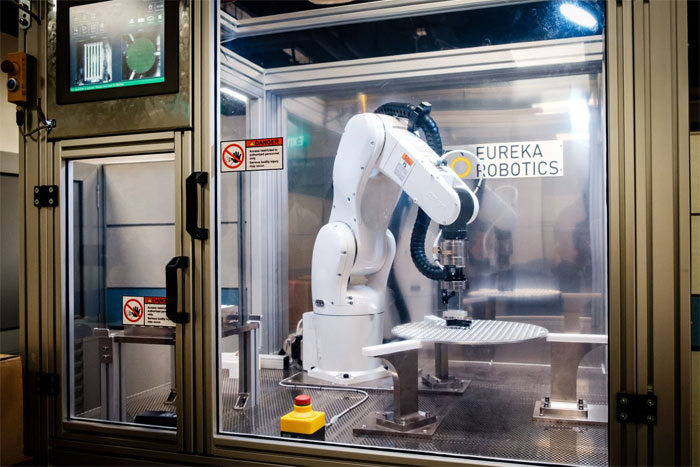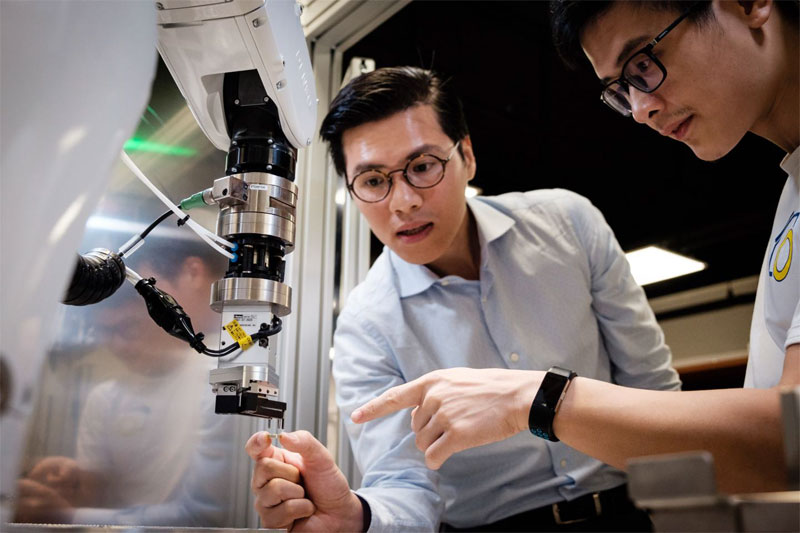SINGAPORE, Oct. 11, 2019 — A robotics technology startup from Nanyang Technological University, Singapore (NTU Singapore), has introduced a new robot that can pick up delicate optical lenses and mirrors with care and precision, just like a human hand. Named Archimedes, the robot can slot lenses and mirrors of different sizes into a custom loading tray to get them ready for coating.

NTU spinoff company Eureka Robotics developed Archimedes, which has the precision and dexterity of a human hand. Courtesy of NTU Singapore.
Archimedes has a six-axis robot arm controlled by algorithms that use artificial intelligence (AI) to plan its motion and how much force to exert in its grip. The system can mimic the dexterity of human fingers and the visual acuity of human eyes. Archimedes is among the first robots with High Accuracy-High Agility (HA-HA) to be deployed on the manufacturing floor, the team said.
“With Archimedes, we have taken accuracy to the tens-of-micron level,” professor Quang-Cuong Pham said. “Its accuracy of placing objects is within a tenth of a millimeter, yet it does so with the gentleness of a human touch, made possible by our control algorithms.” Pham is the founder of Eureka Robotics, the NTU spinoff that developed Archimedes.
The robot uses AI to analyze the number and respective sizes of lenses. An algorithm then plans the most efficient way to slot the lenses onto the tray, and an alert sounds once the task is complete. It takes Archimedes as long as a human operator to slot optics into a designated tray, but the robot could free the operator to focus on higher-level tasks after taking three minutes to start it on its job. Using AI-powered robots will also enable manufacturers to collect real-time data that can be analyzed to improve production processes.
Eureka Robotics will be delivering Archimedes to a U.S. laser optics manufacturer. It also plans to look into adapting the platform for other types of manufacturing processes currently done with manual labor, such as drilling and tapping of custom machinery.

Associate professor Quang-Cuong Pham (l) working with lead engineer Tien-Hung Pham on Archimedes. Courtesy of NTU Singapore.
“Archimedes does laborious and repetitive tasks, so humans can be freed up to do more creative and meaningful work,” Pham said. “Companies can then improve productivity, efficiency, work safety, manufacturing outputs, while optimizing labor.”
Pham will introduce Archimedes at Industrial Transformation ASIA-PACIFIC 2019, which takes place Oct. 22-24 in Singapore.
Associate professor Quang-Cuong Pham (l) working with lead engineer Tien-Hung Pham on Archimedes. Courtesy of NTU Singapore.
Associate professor Quang-Cuong Pham (l) working with lead engineer Tien-Hung Pham on Archimedes. Courtesy of NTU Singapore.
Introducing Archimedes, a robot with a human-like grip that can pick up delicate optical lenses and mirrors with care and precision, and slot lenses. Courtesy of NTU Singapore.